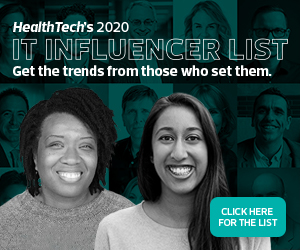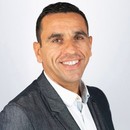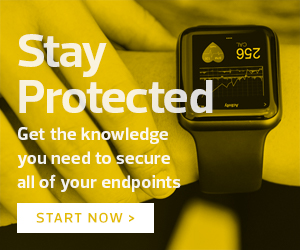“Wearables have the potential to change the world.”
While João Bocas’ statement is bold, you might find yourself wholeheartedly agreeing with him after just a brief conversation. His passion for wearable devices and their potential benefits for healthcare was evident in a recent call with HealthTech.
“I believe the combination of wearable technology and artificial intelligence will be the true game changer for healthcare,” Bocas says.
While making our list of 30 Healthcare IT Influencers Worth a Follow in 2020, we reached out to this former professional soccer trainer turned thought leader to explore the current landscape for wearables — and what challenges these devices still present for providers. Here’s what he had to say:
HEALTHTECH: How do you see wearable devices in healthcare being affected by the pandemic?
BOCAS: I see it from two angles, really. First of all, less developed companies are being affected at the moment in terms of R&D, slowing down the innovations, the resources, the developments and even the funding. That’s also slowing down all of the plans to go to market.
From the other angle, I think the pandemic really highlighted what we were supposed to be doing in terms of healthcare with wearables for a long time — and I’m talking about remote patient monitoring capabilities. COVID-19 really highlighted the need for better deployments in terms of healthcare.
HEALTHTECH: What are some of the ways wearables are helping even more during this time?
BOCAS: Let me outline a scenario: Imagine that 10,000 people are being quarantined in one particular region, with each person having a wearable medical device on their wrist. The devices are continuously measuring the wearers’ skin and body temperatures, respiratory rates, pulse rates, heart rates and blood oxygen — and there are probably other health parameters — but measuring all of these vital signs directly correlated to COVID-19.
We could start the triage, assessment and planning of appropriate interventions early, and at the same time mitigate the health risks of spreading the virus by taking to the hospital only those that require interventions. This would provide that early diagnosis for better outcomes, which is definitely a win-win for patients, healthcare workers and society at large.
HEALTHTECH: What risks still exist when introducing wearable devices as part of a patient’s care?
BOCAS: People are very concerned about their health data and personal details, so there are of course risks and privacy concerns with using wearable devices. I would say, however, they’re secondary risks for sure; they’re not life-threatening.
However, there are a lot of healthcare organizations now that are experiencing cybersecurity issues. Healthcare is more prone to cybersecurity risks because there are more entry points for hackers. Also, because the data is transmitted more often, it presents a higher risk of leakage.
HEALTHTECH: What do you find most challenging about implementing wearable devices like smartwatches into a patient’s care plan?
BOCAS: I think that a lack of information and education around the use of wearables and medical devices is always a missing piece. I did a project on health wearables engagement — it’s a 159-page report — and one of the things that we noticed was a lower engagement in intrinsic motivation of patients. They’re not getting results because of lack of or poor education around using the wearables.
Sometimes it’s a simple thing, such as forgetfulness — for example, forgetting the device, forgetting to charge it or forgetting to use it. Then there is no benefit, because if you’re not using it, we can’t get the data. In clinical trials this happens very often: People go for trials for six months; they break the pattern and then there is no data and the study is obsolete. So, it’s very important to have a sustainable engagement with the patient and the device.
HEALTHTECH: How is this user-related barrier being addressed?
BOCAS: I think one of the solutions is implementing the devices that are more sustainable. Let me give you an example.
We encountered a lot of battery issues in our report, and part of the challenge, we found, is that the devices are also a bit bulky or uncomfortable. One thing that is now becoming very popular are the smart patches for gathering many vital signs from a single patch, but even these only have four or five days of battery span across the board.
One of the solutions is to try to work with wearables and medical devices that give you a further remote monitoring ability of around 20 or 30 days. There are a lot of innovators that are trying to crack that challenge in terms of battery life.
HEALTHTECH: What other device-related barriers still exist when implementing wearables in a healthcare setting?
BOCAS: One of the conclusions that we took away from the report was that connectivity and interoperability are probably the biggest device-related barriers. Those were some of the top challenges that we extracted from the report. Even though we have open APIs and we have systems that communicate to each other, we see, for example, that different hospitals have different technologies from different providers and different vendors.
The fact that there is a bit of a communication issue in terms of interoperability also brings a lot of complexity with it. It’s not just bringing the devices on board; it’s a piece of work that needs to be done in terms of planning and in terms of connecting all the pieces together while also engaging the right people at the right time.
HEALTHTECH: What do you think is most exciting about the use of wearables in healthcare going forward, and what do you hope to see next?
BOCAS: What interests and excites me the most is the potential to diagnose and identify health complications at an early stage — and wearables certainly add a lot of value there, especially in terms of atrial fibrillation. Ischemic heart disease is still the No. 1 cause of death worldwide, according to the World Health Organization, followed by stroke and chronic obstructive pulmonary diseases. Wearables have a really crucial part to play there, I believe.














